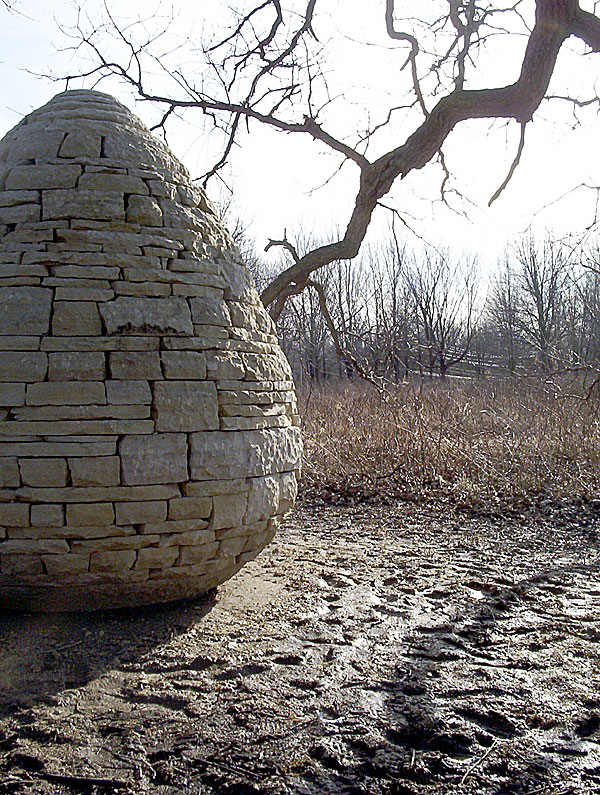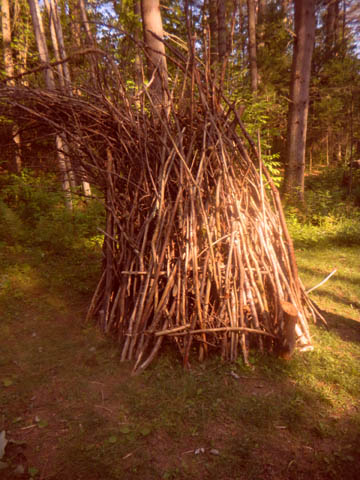Artists Taking Action

Created for Best of Artists and Artisans web site
By Bridgette Mongeon © 2008
Recently I received an e-mail in my inbox that caused me to clean my clay filled hands and take action. It was from sculptor Boaz Vaadia in Brooklyn, NY, expressing urgency in supporting the Artist deduction bill S. 548 and HR 1524. The e-mail included links to Americans for the Arts. This is a wonderful organization that is working for each of us. According to their website:
Americans for the Arts is the nation’s leading nonprofit organization for advancing the arts in America. With 45 years of service, we are dedicated to representing and serving local communities and creating opportunities for every American to participate in and appreciate all forms of the arts.
This bill S. 548 and HR 1524 is described on the Americans for the Arts policy and advocacy page, but let me sum it up in this article.
Since 1969 those working in the arts have not been allowed to deduct the fair market value of their artwork when donating it. The bill “would allow creators of original works to deduct the fair-market value of self-created works given to and retained by a nonprofit institution.” Currently, those working in the arts can only deduct what it cost to create it. Here is some more information from the Americans for the Arts website that indicates the importance of this bill and how immediate the effect of the 1969 legislation was.
- The Museum of Modern Art in New York received 321 gifts from artists in the three years prior to 1969; in the three years after 1969 the museum received 28 works of art from artists—a decrease of more than 90 percent.
- The biggest loser was the Library of Congress, which annually received 15 to 20 large gifts of manuscripts from authors. In the four years after 1969, it received one gift.
- Dr. James Billington, Librarian of Congress, says, “The restoration of this tax deduction would vastly benefit our manuscript and music holdings, and remove the single major impediment to developing the Library’s graphic art holdings. [The] bill would also benefit local public and research libraries. When this tax deduction was allowed in the past, many urban and rural libraries profited from the donation of manuscripts and other memorabilia from authors and composers who wanted their creative output to be available for research in their local communities.”
H.R. 1524 and S. 548 are identical to legislation that the Senate has passed five times in the past few years, but that has not been reviewed by the House.
This bill affects every creative person, not just sculptors. Please take note.
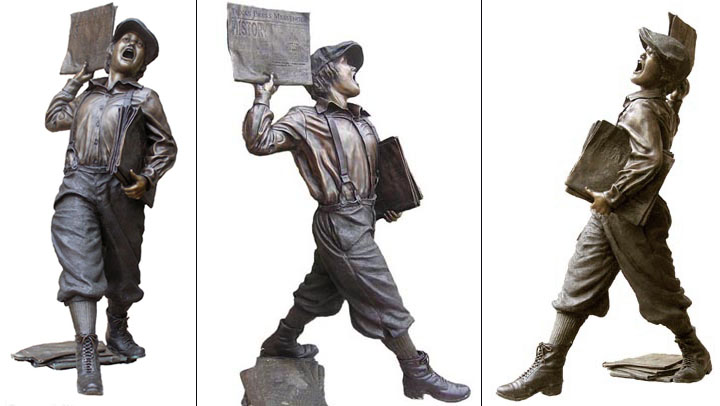
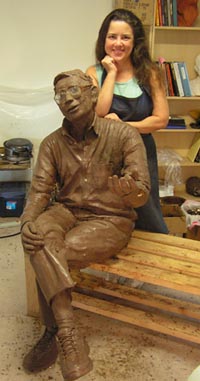
Since I learn best by example, here is one for you to ponder. I have created a life-size newsboy sculpture. There are 10 in the edition of the life size sculpture and they sell for $23,000. I have sold two in the edition. One for the Texas Press Association, who commissioned me to create the piece, the second for the Tabor City Tribune. It costs me approximately $6,000 to pour the newsboy in bronze. I have worked hard to develop a reputation as an artist and to sell the remaining in the edition spending hours on press releases about “Carving newspaper headlines in history,” documenting the process on my website and in an online video number one , and number two. I spent many hours and a great deal of money in mailings and marketing. It would make my heart skip a beat if I could somehow get one of these newsboys into the Albright Knox Art Gallery in my home town of Buffalo, New York. If somehow I could find the funds to pour the sculpture and donate it, and if they accepted the piece, I could only deduct the $6,000- the cost of pouring this sculpture as my tax deduction and not the entire $23,000 That is a loss of $17,000 of income for my sculpture and my pocket book. However, if someone else bought the sculpture and donated it, they could deduct the entire $23,000.
Another example is a piece I am currently working on of Richard Hathaway of Vermont College Union Institute and Goddard College. I am donating my labor and part of the casting costs, a total of approximately $25,000. The City of Montpelier has donated the cost of casting the sculpture. It will be installed this year at the TW Wood Gallery in Montpelier, Vermont. My taxable deduction for a year and a half worth of work $0.00.
I contacted the executive director of the St. Louis Volunteer Lawyer and Accountants for the Arts. “Unfortunately, I often deliver bad news to artists: they can only claim the cost of their materials when they donate a work of art to a nonprofit organization, while a collector can claim the fair market value. The proposed legislation, which includes some caveats, would allow some artists to receive an equitable tax deduction. It’s been on the table before, but it looks like it has some momentum this year, so artists should take a moment to contact their legislators,” states Sue Greenberg.
The Americans for the Arts website makes it quite easy to get involved. By going to the artist’s action center you can fill in your zip code and see if your senator supports the bill. There is a simple form for you to e-mail to your representative or print out a letter with your request for support.
I know it is difficult to take time away from our creativity to become politically involved. It is however, very important to our livelihood. Thank you for your support and your actions.
Here is an update on some of my Creative Endeavors!
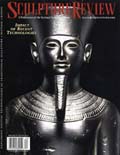
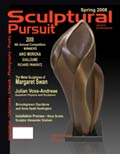
Recent articles written by Ms. Mongeon
“Exploring Digital Technologies as Applied to Traditional Sculpting.” Sculpture Review. (Winter 2007) 30.
“The American.” Sculpture Review. (Winter 2007) 32.“Artful Business-The Basics of Designing your Website.” Sculptural Pursuit. Vol. 7 No. 1. (Spring 2008) 50. March 2004
All written work is copyrighted and cannot be used, whole or in part,
without the written consent of the author.
PRESS RELEASE- Alice in Wonderland is on Her Way Home to Houston, Texas

Sculptor Bridgette Mongeon sits in the Alice Chair at Deep in The Heart Art Foundry. She and Alice are waiting for Alice to come home to Houston. Photograph by Christina Sizemore
PRESS RELEASE
150 Years ago Alice fell down a rabbit hole that sent her on a very curious adventures. Sculptor Bridgette Mongeon has been on her own journey in a rabbit hole. Hers began with concept sketches six years ago, when she was creating a sculpture of Evelyn Rubenstein for the Evelyn Rubenstein Jewish community center in Houston, Texas and heard that there might be another sculpture needed for Evelyn’s Park. The Rubensteins would place the sculpture in a special memorial garden to honor Evelyn Rubenstein. They visited the famous Alice sculpture in Central Park. Jose De Creft created that Wonderland theme. George Delacorte commissioned the sculpture, and it was unveiled in 1959. The Rubensteins brought pictures to the artist. The spark of inspiration was ignited for Mongeon’s sculpture titled “Move One Place On.”

Sculptor Bridgette Mongeon and her granddaughter search for the 150 things hidden in the sculpture. Photograph by Christina Sizemore
The sculpture consists of a ten-foot table with a dormouse shoved in a tea pot, just as in the story of Alice’s Adventures in Wonderland. Three benches offers seating for guests, and one has a chess board in it so, be sure to bring your chest set. A nine-foot Mad Hatter flanks the 24-foot long sculpture on the left. He pushes out of his chair which is complete with arms in the shape of a lion and unicorn and feet of the chair like flamingos. The seat is unbalanced and toppling over as the Hatter stands up, gesturing to the end of the table and pouring tea. The March Hare sits on a stump at the center of the table talking to the guests to his right while dipping a watch in his tea. Alice watches on from a large overstuffed chair. The Cheshire Cat sports a “curious” beatnik look an rests on top of Alice’s chair. There is plenty of room for guests in the the coveted seat next to Alice. The artist created the sculpture so that each character interacts with an empty place, in other words, the scene is not complete until you are there.

Issa Sizemore talks with the March Hare about how her gamma created him. Photograph by Christina Sizemore
If feasting at the table and visiting with fanciful creatures is not intriguing enough Mongeon has hidden 150 things in the sculpture in honor of the 150th anniversary of the endearing story. The treasure hunt begins at the dedication plaque shaped as a storybook, balanced on a tree trunk. There is a small stump for children to step up and touch the mouse that rests on a leaf as parents read the dedication. Look at the top of the storybook and you will see the feet of a small white rabbit jumping down a hole at the top of the book. Walk around the stump, and you will see a cut away from the hole where another very small Alice is falling. This dedication plaque begins the search for the 150 hidden things.
Many have asked if there is a master list of the 150 hidden things? Only in the artists head. She will begin to reveal the hidden things through riddle and rhyme in a book and online at alicesculpture.com, the findingalicesculpture Facebook page and Instagram. She has provided a free detective notebook for families and individuals who might like to document the 150 hidden items. You can find a link to the notebook and other free printables at www.alicesculpture.com.

Bridgette Mongeon shares with her granddaughter some of the 150 hidden items. She reminds Issa, “Be sure to check the buttons.” Photograph by Christina Sizemore
An avid reader Mongeon hopes that the scene will encourage literacy, but the educational element has gone way beyond that. The creation of “Move One Place On” was a chance to educate children and adults in STEAM. STEAM is an educational initiative that focuses on Science, Technology Engineering, Art, and Math. Mongeon, Alice, and her friends have helped to present STEAM in Wonderland to adults and children at the Bellaire Library, and at Young Women in Math and Science. Mongeon also presented it at 3D Printing World Expo, the Lewis Carroll 150th anniversary celebration, and last November art teachers all over Texas were introduced to STEAM in Wonderland at the Texas Art Educators conference where Mongeon was the keynote speaker. Mongeon is excited about creating more educational opportunities and is presently working on free curriculum for schools and homeschoolers. She thinks the author Charles Dodgson AKA Lewis Carroll, would approve. After all Dodgson was a mathematician.
The sculpture has been completed by Deep in The Heart Art Foundry in Bastrop, Texas and installation is planned for early April. In March Mongeon traveled to Deep in the Heart for a metal check and to direct patina on the metal sculpture that weights in near 6,000 lbs. Now that the foundry has the artist’s approval, it will travel through Texas on an open bed trailer from Bastrop to Bellaire and Alice and her friends will have their final resting place in Evelyn’s memorial garden in Evelyn’s Park. Keep an eye out for Alice and the gang. You just might see them coming down the I-10 freeway.
While at Deep In The Heart art foundry open house the artist visited the sculpture with her five-year-old granddaughter Issa Sizemore. The artist created the artwork in pieces and sent it to the foundry to expedite the process. Even though she created it she had never seen the entire scene altogether. Issa has watched the sculpture take shape and grew up with the design. At the open house, Issa acted as a tour guide climbing all over the sculpture and sharing the secrets of the hidden items. Guests will spend more time under the table than on top of it as the artist says there are approximately 60 things hidden under the table, including many doors to magical places.

Children and grown ups alike will fall in love with this tea party experience. Photograph by Christina Sizemore
Bellaire and Houston will now have one of the most coveted dining experiences in Texas. The curious adventure created with Mongeon’s work “Move One Place On ” will continue to intrigue and delight people of all ages.
Dedication is scheduled for April 21, 11-4
Evelyn’s Park
4400 Bellaire Boulevard
Bellaire, Texas 77401
281.946.9372
info@evelynspark.org
Alice Project- How it Began – Getting Ready to Jump Down The Rabbit Hole
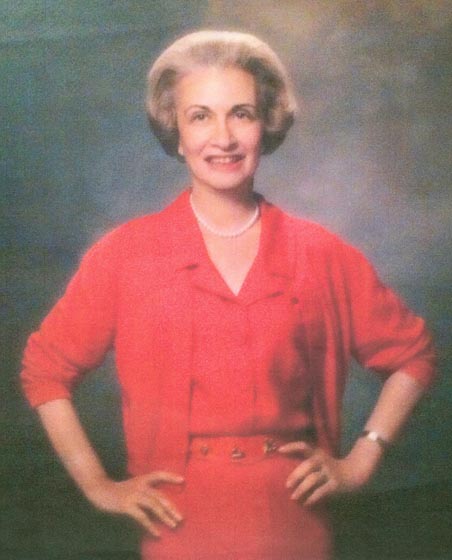
In 2011, I was contacted by Amy Freeman of Freeman Design Associates who was working with Jerry Rubenstein on signage for the newly named Evelyn Rubenstein Jewish Community Center. The Rubensteins were looking for an artist to create a bronze sculpture of their mother for the Jewish Community Center. If you are interested, I documented the creation of Evelyn on a website blog. The Rubensteins and Amy came to my studio, and we all hit it off. At this time, the Rubensteins were also talking about a possible second sculpture of Evelyn for a park. My focus was on the sculpture for the Jewish Community Center, but I was curious about this mention of a sculpture for a park.

Over the many visits to my studio, Jerry and Linda would share artwork and artists that they discovered, I assumed they were ideas for the park. One such piece was the Alice In Wonderland sculpture in central park. Over the years, I have received numerous photographs from the Rubensteins of this sculpture, but I have yet to see it for myself. My wheels began to turn about Alice. I was delighted to find that the story and illustrations were in the public domain, I was even more delighted to find that the story would be celebrating 150 years in 2015. I immediately purchased an The Annotated Alice,Diliberto Photo and Design helped. We had so much fun searching for all of these elements and putting them together in this very classy package.

presented it along with the book to my client. Securing a great commission
like this take a lot of time and finesse.
I have sculpted quite a few deceased loved ones. It is my specialty, and I develop a certain connection to the loved ones. Last year the Texas Country Reporter came out and created a wonderful segment on this part of my artwork. You can see it on this YouTube video. You could say when doing this type of artwork…I develop a relationship with the deceased, and though I had never known Evelyn, I became friends with her as I created the sculpture for the Jewish Community Center.
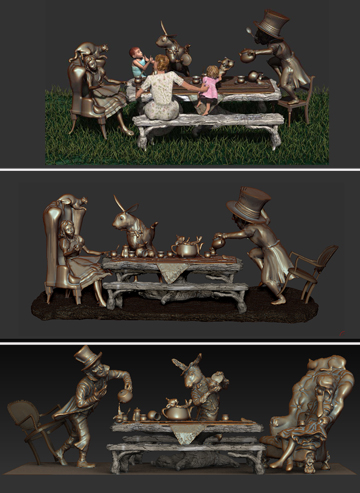
sizes. 1. digital sketch for client to get the feel for my idea.
2. Digital sketch enlarging characters 3. The clay sculpted
maquettes added to the scene and sized proportionately
to each other. These last scene is the truest to how the
large scene will look, but it continues to morph and change.
Not long after beginning the sculpture of Evelyn in 2012 I began to create digital designs to present to the Rubensteins. I had several designs that I spent hours on and never presented. The one design that had me was Alice. I just kept coming back to Alice.
The interesting thing is that, originally the Rubensteins did not want just a random sculpture, they wanted another portrait of Evelyn. Over time, I think Alice and her friends won the heart of the Rubensteins. Or maybe I’m just a good sales woman, I’ll never know, but this sculpture as it has morphed between my client and I, will be a destination spot when people come to Houston. Visitors will enjoy the interaction and the most coveted dining experience in Texas. I think Evelyn would be proud for all that it represents, family, imagination, literature, creativity, and fun.
Over the next three years, I modified the designs, and Alice grew from a life-size sculpture to a monumental sculpture with the mad hatter being 8 feet tall. At one point we talked about making the table much, much larger to accomodate more guests, but instead brought it down to this intimate size. Originally I had designed the sculpture to be a mix of materials-bronze and faux bois. Faux bois is concrete that is made to look like wood. The table and benches would be this faux bois. The first designs of the project were going to be a collaboration of myself and two master faux bois artists Donald Tucker and Cindee Klement. The work of these masters is nothing less than yummy, but the client changed the material desiring all bronze. Maybe one day I will see the mix of these two mediums, but it was back to the drawing board one more time.

In the last of the project designs, I had created and suggested an additional sculpture of Evelyn on a faux bois bench petting a large grey poodle. The Rubensteins had just lost their long time furry companion and because I love dogs and also specialize in pet memorials. I thought this might be a good addition to the park. I still hope that one day this additional piece will be added to the park. I loved the idea of Evelyn sitting back and watching everything that was taking place in her special wonderland, and I thought kids would love to interact with the dog as much as the other art. But budget and time were an issue, and we narrowed it down to the characters, table, benches, and podium with the book. To sculpt all of this in such a short amount of time is still a massive undertaking. Be sure to watch to see how I do this on both this blog and the Finding Alice Facebook Page
The idea of hiding things in the wood was an early decision of my own. At first I was not going to tell anyone. When I found out it was the 150th anniversary of the story, the “150” becomes a personal challenge for me. Plus after reading the annotated Alice I realized there were so many hidden things in Lewis Carroll’s original story that I have much from which to choose. I’m delighted to be writing two books on this project one about he process from start to finish and documenting all of the technology used in the creation. The Alice Process book will be very similar to my new book coming out in Sept called 3D Technology in Fine Art and Craft: Exploring 3D Printing, Scanning, Sculpting and Milling. Unlike the 3D Tech in Fine art book, which features artists and work from all over the world, this new book will feature just the art and technology used in Alice, I can’t wait to show you, as it is pretty incredible.

The other book I will create, after the sculpture is done being sculpted and off to the foundry, is a field guide written in Rhyme and riddle. It is about the 150 hidden elements. Note: this does not mean just 150 hidden things. There are meanings behind the pieces that are a part of the hidden elements. So, take out your the Annotated Alice,my blog and to the Finding Alice Page to see how we progress from here. If you have not seen the YouTube video on the project, it describes some of the ins and outs of the project and technology better than can be explained right here. Get ready… this should be a curious adventure. Thanks for coming down the rabbit hole with me.
RIP B. B. King- Thank You For “Signing My Bust”
Some people have reported they can’t either see or hear the video. I have posted it two ways and hope to resolve that.
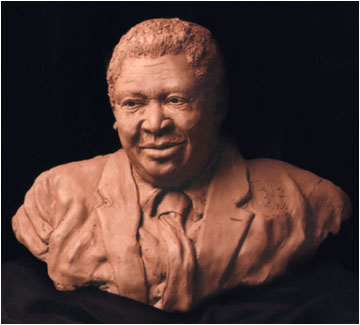
Note: After writing this post, my now grown daughter created a post on her business blog titled The ” Day B. B. King came to my house for dinner.” She was about 5 when this happened. Her blog post should be read by any creative person who has even a little guilt about being a parent and following your dreams.
Also, KHOU came to my studio and created a segment on me after this post came out. You can see it here or by viewing
Thank You, B. B. King
Many years ago, I was young, and my dad would look at me with a faraway gaze as I talked about my plans and business accomplishments. Then he would say, “Ah to be filled with spit and vinegar.”
I had found my creative calling. I found clay. I fell in love with molding things from the deep earth, while experiencing the sweet smell. I enjoyed pushing, pulling and coaxing it into shape. Sculpting was what I had hoped would be my career- I wanted to be a portrait artist. I did what other artists through the centuries have done. I asked myself, “What person could I sculpt that would make a difference in my career as an artist?” I had already sculpted Willie Nelson and presented him his bust at the Houston Livestock show and rodeo, but that is an entirely different story. I love the blues, and when I heard B. B. King was coming to Houston, I thought he would be a wonderful person to sculpt.

Those watching my career back then called them “notches in my belt.” Some accomplished artists told me “You need to pay your dues,” if that meant I needed to struggle, I had had plenty of that in my early life. If struggle was all I needed, I often thought I did not need to pay dues, but should by this time in my life, have a full-time membership. I was on a journey of making a living at working in clay and a bust or more than that— a personal sitting with B. B. King was something I thought I should try.
How did I get sittings with the entertainers, many ask when I lecture on marketing in the arts to artists and musicians. In these lectures, I often encourage the audience in tenacity. I guess I am lecturing on “spit and vinegar.” I help them to realize that they are not alone in their insecurities and obstacles. All artists have them. The key to success is rising above the insecurities and keep going “full speed ahead.”
In the case of my sculpture sitting with B. B. King, it took a bit of chutzpah, as my Jewish friends would say. This guttural, back of the throat word is perfect to accentuate the grasp of the waiting, and the pushing and the prompting that it took. But the simple first step was that, “I asked.”
In reality, getting an audience with a legend was not nearly as simple as just asking. There were a lot of minutes of insecurity as the possibilities balanced precariously on each of my actions. “Who should I talk to, how should I approach them, Who do I need to find? How will this workout? These questions prompting me to action were accompanied by “What am I doing, and why would this person give me their time?” I never doubted my ability as an artist; I knew I could create a magnificent likeness, and I was anxious to try. I knew the passion I felt for this man’s music would transfer from my fingers to the clay. Later in life I would study the science behind how this happens—how I could capture the essence of someone. I wrote about it, especially when it pertained to deceased loved ones and people I have never met. But at the time of my experience with B. B. King, though I didn’t know the science behind how it happend, I just knew I could create a likeness if I were given the chance.
There is a happy dread in that moment of first introduction. It happened when he arrived at The Hard Rock Cafe in Houston, Texas. They scheduled him for a personal appearance. Securing my audience with him or at least his manager required a tremendous amount of chutzpah. If you could hear my effort in that word in those moments, you would think, I was coughing up a lung. For I needed chutzpah again, and again, and again as I encouraged and held on to the belief in myself and mustered up that spit and vinegar.
Those connections are easier for me now. I realize they are all just people, and I’m blessed if something comes from our meeting. If my work can inspire and encourage them, I’m even more excited. My age has calmed me in these meetings. In hinsight, looking back it probably didn’t hurt that, at that time, I was somewhat of a looker. Though I had no idea I was, and I was a bit neive to the concept and power of being a “looker.”
My friend helped me with finding our way, and we dubbed her as my temporary “rep” lending a bit of importance to me. Together we meandered and worked the appropriate people at the Hard Rock Cafe until the sitting was secure. The next day we would meet at the Allen Park Inn, Mr. King’s hotel, where he always stayed. Over the years, time and progress have assisted with the demise of the Allen Park Inn, it is no longer there. At that time in my life, I knew about the Allen Park Inn only for their bar’s manhattans. I was not a drinker of manhattans but in this previous life I was in advertising and worked next door to the Allen Park Inn at a place called Metzdorf Advertising Agency. My boss went to the Allen Park Inn regularly for lunch… and their Manhattans.
Pulling into the Allen Park Inn I muttered, “I’m simply parking my car at a hotel.” I parked in the furthest space, for from time to time, this car would have a tendency to smoke, and on bad days it would start on fire. I grabbed my calipers and measuring tape and papers, stepped away from the car, looking back to the engine to see if I should take concern before entering the hotel. I was happy that I would not have to use the extinguisher I kept in the back seat or dial 911 and cause a scene. I entered the hotel. “I’m simply searching for the room where I will have a sitting with B. B King.” I silently told myself. My heart was a flutter not just at meeting the man, but at the idea that I was starting a real career as a portrait artist. I held tight to the goal in my heart. Somehow, with tenacity, chutzpah, and the spit and vinegar passed on to me through my daddy, and with B. B. King’s help, I would work my way up and out of advertising. I would be a full-time commissioned sculptor.
Reminiscing on paying my dues, I realize that the most important belief in myself had to come from me. Counting others to believe in oneself is senseless. You are the most important thing to you. Sure, many people were interested and helped me along the way. But just as many people didn’t get what I was trying to do with a career as an artist and prompted me to —”get a real job.”
During the sitting in “conference room A” of the Allen Park Inn, I sat side by side with B. B. King. He was a very large man with an enormous but gentle personality. There are several people in my life that I had met and when I met them I had an instant bond to them. B. B. King was one. Interestingly enough, I had the idea that he somehow knew how he would affect my life. It was if our time together was rehearsed. I don’t think I can explain that.
With each of the legends I have sculpted, I have often wondered about their life, their personality their journey. The writer in me would have loved to sit and chat to know about where he came from to document his process of “paying his dues.” The artist in me uses these conversations and emotional connections to pull in that essence, I mix it with craft and add it to my clay.
During the sculpting process, I take photographs all around the subject. I also need measurements. I don’t have the luxury as artists of old did. The classical artists would have a person sit for them. I desire such commissions. In this sculpture “sitting” of old, the artist would converse and get to know their subject. There were often days spent together. The artist would often reside in the subject’s homes. These sculpture sitting could last for weeks or even months at a time as the artist would work at the convenience of the royalty that they were sculpting. I see now how these encounters could make a difference in the lives and careers of the artist of old. Unless, of course, the artist were not charming and made a horrible houseguest. These long-term and personal encounters would have done a great deal for the client and artist, they would have cemented the relationship into a friendship and in turn they would become a patron of the artist. I believe it is the artist’s personality as much as their work that people buy.
I have no such luxury with the sittings of old though I would one-day love to do have such a sitting and develop such relationships. My first sculptural sittings are to obtain photographs and measurements. I take measurement with an instrument known as calipers. Calipers are two pieces of metal that are hinged together and curved at the front. When I have sittings with children, I tell them the calipers are a duck beak. I often sculpt children and had at one point a fantasy of being the portrait artist preferred by the stars. I would capture the memories of their children. I have sculpted many, many children, not that many that were famous, but they are one of my favorite things to sculpt.
When taking measurements I put one end of the calipers at one point, say the notch of the ear, and the other at another point say the chin. I tighten them and then lay that measurement on my ruler, recording each measurement precisely. There are about thirty measurements that I take for a portrait bust. Of course when I’m sculpting deceased loved ones there are no measurements, so often I will create the masterpiece with just images. This second part of the sitting is the taking of photographs all around the subject.
Most people have no problem with being measured, but some people do not like their faces touched. I wanted to make this part of my process known to B. B. King, just in case he was one of those who did have trouble with being touched. My hands and calipers in my lap, I pulled my chair up to his side.
“Mr. King. I’ll have to touch you during this sitting.”
He looked at me and with that same bluesy conviction and said, “Darling you are already touching me.”
I looked at my hands and laughed, with a bit of concern in my breath. He eased my confusion.
“Your thigh is against my thigh and, believe me, the thrill is not gone.”
Of course, everyone in the room laughed, and that interaction broke any tension there was in the room.
The initial sitting did not take long. Mr. King went back to whatever a musician does at an obscure hotel in Houston, and I went right to work. I would not see B. B. King until the following day when we would have the second sitting. I developed my pictures at a one-hour photo processing company and sculpted all night long.
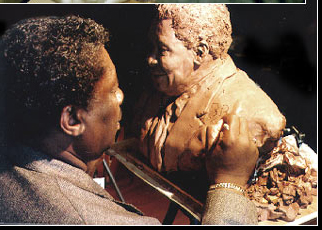
I worked fast and furious through the night with the help of coffee and blues music playing in the background. I didn’t have a studio back then. Remember, it was the beginning of what I hoped would be a career. No, I worked between two confining walls in the smallest room in my home, with blue music playing in the background, I sculpt/danced, as I sometimes do when the mood strike. Mr. King was coming around dinner time the next day for the final sitting. I had less than 24 hours to complete the work.
The next day he arrived in a limousine, and I was glad that there were no neighbors out to greet him. I kept the entire thing on the down low, but later neighbors chided me. Celia across the street was the spitten image of Mom’s Mabley. If you are familiar with Mom’s Mabley, you can visualize what the encounter looked like the day she heard B. B. King was in my home, and she was not invited. Neighbors did learn to pay closer attention when they saw a limo in my middle-class driveway in this unassuming neighborhood.
I had prepared for Mr. King’s visit by wheeling the bust into the living room on a sculpture stand. I placed a chair where Mr. King could sit in the center of the room and rotated my sculpture stand around him making final touches on the sculpture and checking my proportions. When I finished, I invited him to take a closer look. He commented on how erie it was to look at himself and feel that the sculpture might talk. I handed him a sculpting tool, and in the playful mood from the day before I sheepishly smiled showing my dimples and asked, “Mr. King, would you sign my bust?”
Now it was he that had that surprised look in his eye as I assured him, “The sculpture Mr. King.”
He signed his signature near my own.
Upon completion, my “rep” had prepared a southern meal, hoping to releave B. From his continuous travel and restaurant meals. (Mr. King told us to call him B. But I just could not, and continually referred to him as Mr. King. I have grown up in the south and also refer to men as sir, so when I was not responding with Mr. King, I would often say, sir. )
After my final sitting, we would sit around my scuffed antique table under the wicker chandelier dining on greens and meat and sharing stories. Though I’m not partial to greens and my best sustenance at that meal was my accomplishment, even though I had little to no sleep I had completed the bust.
Mr. King invited us as his personal guests to the show that night at Rockefllers. Rockefellers was his choice venue when he came to Houston. Not a big amphitheater, but instead it is brick building created by renowned architect Joseph Finger in 1925. For years, it was Citizen’s Heights Bank. Rummor says that Bonnie and Clyde held up this bank. From 1979-1997, it was B. B. King’s preferred venue. It seemed to go with his charm and warm nature. It is no longer open to the public for such events unless you are getting married. My… things have changed over the years.
The balcony of Rockefellers runs around along the inside perimeter looking down on the marble dance floor, made into a seating area for the intimate audience. The stage ran along the back. As his “preferred guests” we were let in the back door behind the stage. Behind stage passes sound wonderful, unless you have been up for 24 hours sculpting and could think of nothing more than sleeping, or at the very least—sitting. I learned a very hard lesson that evening. A lesson that I would take with me the rest of my life and when sculpting other entertainers. To everyone else a concert is a party atmosphere, it is a laid back atmosphere, but for me… it is still work. I didn’t party, but I was exhausted. I was thrilled to be there but listened to the urging of a friend who saw how tired I was and said, “You should go home and sleep. You stayed for one set.”
Here is my hard lesson. My “rep” told me the next day that after the concert B. was looking for me and wanted to introduce me to everyone in the audience as his “official sculptor.” I was mortified. I told her, “You told him I had been up all night sculpting, didn’t you.” She assured me she had and that B. said, “Tell Bridgette, that is is not over until the curtain comes down.” I have remembered that all of these years. Even if I have sculpted 24 hours and I am exhausted, I will put in the overtime. I’ll continue till the falling of that final curtain when I can rest my head with my accomplishment and know that I did everything I could do. At that time, I will call it an evening.
I never gave Mr. King the original bust. I was unable to afford to have it cast. I sat the first one next to the original and copied the sculpture in clay, I fired it and had it sent to Mr. King. I still have the original bust with both of our signatures in my studio. I fully intended to have it cast in bronze. Maybe I will pull it out and do that now. It would be good to see it, make the mold and reminisce of our time together.
Our interaction nearly 30 years ago was my last. I am sorry for that, as I am certain he had many important things to say, and as I said, when we met I felt it was meant to be—a certain destiny between us. I have no idea what stories other people have to tell, but mine were sweet and pivotal in my life. I am so very thankful for the opportunities he gave me. I’m thankful for the sculpture, the stories, and the interaction. As I enter into new areas in my life, and new commissions as an artist of not only portraits but much more, I will look back on that experience with love.
Your final curtain has gone down, rest in peace Mr. King. Thanks for the “thrill” and for signing my bust.
In his words
Better not look down
If you want to keep on flying
Put the hammer down
Keep it full speed ahead
Better not look back
Or you might just wind up crying
You can keep it moving
If you don’t look down
Bridgette Mongeon is a sculptor, writer, illustrator and educator as well as a public speaker.
Her blog can be found at https://creativesculpture.com.
Follow the artists on twitter twitter.com/Sculptorwriter
Listen to the Art and Technology Podcast
Find her newest book on Amazon 3D Technology in Fine Art and Craft: Exploring 3D Printing, Scanning, Sculpting and Milling.
How the Alice Sculpture Began
In 2011, Amy Freeman of Freeman Design Associates was working with Jerry Rubenstein on signage for the newly named Evelyn Rubenstein Jewish Community Center. She contacted sculptor Bridgette Mongeon about a possible sculpture of Evelyn for the Evelyn Rubenstein Jewish Community Center. The Rubensteins were looking for an artist to create a bronze sculpture of their mother for the Jewish Community Center. Bridgette documented the creation of Evelyn on a website blog. The Rubensteins and Amy came to her studio, and they all hit it off. At this time, the Rubensteins were also talking about a possible second sculpture of Evelyn for a park. The artist’s focus was on the sculpture for the Jewish Community Center, but she was curious about this mention of a sculpture for a park.

Over the many visits to her studio, Jerry and Linda would share artwork and artists that they discovered. Bridgette assumed these were ideas for the park. One such piece was the Alice In Wonderland sculpture in central park. Over the years, she has received numerous photographs from the Rubensteins of this sculpture, but she has yet to see it for herself. Her wheels began to turn about Alice. She was delighted to find that the story and illustrations were in the public domain. She was even more delighted to find that the story would be celebrating 150 years in 2015. She immediately purchased an The Annotated Alice,which features both stories of Alice’s Adventures in Wonderland and Through the Looking Glass. Later she purchased another copy of the annotated Alice. She created a book mark, with the most recent image suggested for the park, strung charms of a tea party to it and presented it to Jerry. Her daughter who is the owner of Diliberto Photo and Design helped. She had so much fun searching for all of these elements and putting them together in this very classy package.

She has sculpted quite a few deceased loved ones. It is her specialty, and she develops a certain connection to the loved ones. In 2014 the Texas Country Reporter came out and created a wonderful segment on this part of her artwork. You can see it on this YouTube video. You could say when doing this type of artwork… she develops a relationship with the deceased, and though she had never known Evelyn, she became friends with her as she created the sculpture for the Jewish Community Center.

Not long after beginning the sculpture of Evelyn in 2012 she began to create digital designs to present to the Rubensteins. She had several designs that she spent hours on and never presented. The one design that had her was Alice. She just kept coming back to Alice.
The interesting thing is that, originally the Rubensteins did not want just a random sculpture, they wanted another portrait of Evelyn. Over time, Bridgette’s thoughts about Alice and her friends won the heart of the Rubensteins. The sculpture has morphed between she and her client, will be a destination spot when people come to Houston. Visitors will enjoy the interaction and the most coveted dining experience in Texas. Evelyn would be proud for all that it represents, family, imagination, literature, creativity, and fun.
Over the next three years, Bridgette modified the designs, and Alice grew from a life-size sculpture to a monumental sculpture with the mad hatter being 8-9 feet tall. At one point she and the Rubensteins talked about making the table much, much larger to accomodate more guests, but instead they brought the size down to this intimate size. Originally she had designed the sculpture to be a mix of materials-bronze and faux bois. Faux bois is concrete that is made to look like wood. The table and benches would be this faux bois. The first designs of the project were going to be a collaboration between Bridgette and two master faux bois artists Donald Tucker and Cindee Klement. The work of these masters is nothing less than yummy, but the client changed the material, desiring all bronze.

In the last of the project designs, Bridgette had created and suggested an additional sculpture of Evelyn on a faux bois bench petting a large grey poodle. The Rubensteins had just lost their long time furry companion and because she loves dogs and also specialize in pet memorials. She thought this might be a good addition to the park. She still hope that one day this additional piece will be added to the park. She loves the idea of Evelyn sitting back and watching everything that was taking place in her special wonderland, and she thought kids would love to interact with the dog as much as the other art. But budget and time were an issue, and they narrowed it down to the characters, table, benches, and podium with the book. To sculpt all of this in such a short amount of time is still a massive undertaking. You can watch the creation of this through this blog and the Finding Alice Facebook Page
The idea of hiding things in the wood was an early decision of the artist. At first she was not going to tell anyone. When she found out it was the 150th anniversary of the story, the “150” becomes a personal challenge for her. Plus, after reading the annotated Alice she realized there were so many hidden things in Lewis Carroll’s original story that she would have much from which to choose. She is delighted to be writing two books on this project one about he process from start to finish and documenting all of the technology used in the creation. The Alice Process book will be very similar to her new book coming called 3D Technology in Fine Art and Craft: Exploring 3D Printing, Scanning, Sculpting and Milling. Unlike the 3D Tech in Fine art book, which features artists and work from all over the world, this new book will feature just the art and technology used in Alice, She can’t wait to show you, as it is pretty incredible.

The other book she will create, after the sculpture is done being sculpted and off to the foundry, is a field guide written in Rhyme and riddle. It is about the 150 hidden elements. Note: this does not mean just 150 hidden things. There are meanings behind the pieces that are a part of the hidden elements. So, take out your Annotated Alice,and watch the process of creating this sculpture. You will have to brush up on these things to be able to completely fill in all of the spaces in the field guide. She will talk about that more on that in a later blog post.
A design is only a design. An artist must sell the idea to their client, and help their client to become so much a part of the creative process that they are invested. In the a case like “Move One Place On” for Evelyn’s Park, which is the title of this sculpture, there are many other things that play a part in when a job can begin. There were committee meetings, city council, permits, budgets, revising designs, modifying estimates, finding vendors, etc, etc. Many of these things were totally out of the artist’s hands. All these needed to be taken care of before things could be finalized with the sculpture. These final details took place on July 3rd,
That means that Bridgette worked for three years on designs, proposals, presentations, budgets, estimates, and revised estimates, enlargements, and changes. She had thought and proclaimed that the project would start “next month” for these three years. There were so many hold ups that she was sure all of her friends and family thought she had made the entire commission up. Believe me, she like Alice, began to wonder if it were all just a part of a dream. She is elated to pronounce that the project officially began on July 3, 2015 the day before the actual 150th anniversary of Alice in Wonderland. What a fitting tribute.
So now you know the morphing and history of this project. Stay tuned to the blog and to the Finding Alice Page to see how we progress from here. If you have not seen the YouTube video on the project, it describes some of the ins and outs of the project and technology better than can be explained right here. Get ready… this should be a curious adventure. Thanks for coming down the rabbit hole with me.
Trying to Goldsworthy
For many years, I have loved the insightful work of artists and naturalist Andrew Goldsworthy. Goldsworthy creates from nature using branches woven into rock, ice balanced, leaves chained together with thorns that wiggling down a stream, rock changing color and balanced rock. He uses reflection in his creations, natural elements and fights against and works with nature to create. It is the juxtaposition of nature and art or nature in art, or art as nature that calls me to marvel.
I think I have also been influenced by Pamela Callender, a classmate of mine from Goddard. Her work appears rather anonymously on campus. For example The Twig sculpture I found on the trail, I thought of it often when I was working trying to do Goldsworthy. I also loved her braided grass, there was an entire section of a field braided. And these balanced stones pop up everywhere during residency. So, I’m exploring, and attempted some of these adventures on my own. It has been very enlightening.
My first attempt to work with nature was building a nest. I gathered my branches and twigs and sliced up my arms with bamboo shoots hauling them indoors, dumping them on the floor where little bug critters scattered. I liked collecting the items. It made me think of my yard in a different way. Not just as plants, but as material. However, I soon came to realize a very important element of this nature gathering and building, especially as it pertains to nests. Birds gather their materials in the cool of spring. I was building my nest in the middle of a Texas summer with 101 temperatures. Sure I brought all of the materials into a cool, air conditioned room, which the birds don’t have access to, but it was already too late. Heat exhaustion set in, and my nest building was put off a couple of days.

One begins to improvise when trying to create only with nature. Mud is close to clay, and it is not unusual that I, as a sculptor, would turn to it. It was a necessary glue for my nest. My finished nest lacks the luster and intricacy of the blue jay nest I found this spring, when interestingly enough, I was cutting back bamboo. But, I managed to get some a semblance of a large nest.
Prior to building it, I had thought of building several nests of different sizes. Large birdie condo’s that I would hang from… bamboo. After nursing my cut up arms, and heat exhaustion, I smoothed my own ruffled feathers and decided—one was enough.
My next project was also going to entail bamboo. Mostly because it needed thinning again. I had envisioned a large cornucopia slithering tube structure that people would walk up to and peer into and marvel. They would see it from afar, like Goldsworthy art and state, “An artist must live here.” They would be forced to stop and to explore the design. O.K. Maybe I was a little influenced by the “Big Bambu You Can’t, You Won’t, You Don’t Stop” by Mike and Doug Starn and Rock climbers using 5,000 pieces of bamboo. It is a project at the Metropolitan Museum of Art. I had seen the work on Sunday Morning with Charles Osgood.

I had made the decision that using metal to secure the armature was certainly acceptable. (Goldsworthy only uses natural elements.) I appeased myself with the thought that this was bamboo, and I was more of a bonsai artist than a Goldsworthy and twisted the bamboo together.
Once again, the bamboo cut up my arms and ants and pollen fell on my head, causing me to sneeze every few minutes. It was cooler outside, but our Texas October and the pollen that it brings, causes havoc with my allergies. Still, I was committed. I created circles of bamboo of different shapes with longer bits of bamboo and grass at one end. I envisioned this circling around the cornucopia in an intricate manner enticing onlookers and making them marvel at my skills. As hard as I tried, it wasn’t working. I began to think that Goldsworthy must have some type of natural guru thing going to get his material looking so… naturally polished. “More armature.” I exclaimed trucking back to the bamboo for bigger pieces, and more ants and pollen in my hair. After hours of stripping and twinning and weaving bamboo, I had what I thought appeared to be an absolutely glorious, incredible looking —mess. Maybe creating out of nature is just not my thing. Before I could let go of the idea, I had thought about taking my large rings of woven bamboo and chaining them together. Perhaps I would hang them from a tree. But then I thought… I’m pushing here.. I threw the piece aside and went on to another idea.
I had wanted to do something in the pond. I loved how Goldsworthy floated branches on water and then set what looked like red berries in the middle of the branches. This thought intrigued me along with the idea of perhaps gluing my red and orange canna leaves to a rock. I read that Goldsworthy used spit, but I had hoped I could use pond water. I abandoned both ideas as I was not sure what my two turtles would do with these creative pieces of art. Any berries or leaves that I brought to the pond could be poisonous. I might create something nice and at the same time murder my reptile friends in the process. Even if the plants were not poisonous, my 10” turtle is inquisitive and hungry and I doubt I could create anything without her poking her head up in the middle. Ah, maybe I have stumbled upon something cocreating, improvisational art with a turtle. If I create anything for my pond, it will have to be something practical like a floating turtle bathing platform.
Goldsworthy also dug small hole and lined them with things. I entertained this idea for just a short second as I was sure that I or my husband or one of our dogs would fall into the hole twist an ankle and end up in the emergency room. I wondered if anyone ever twisted an ankle in a Goldsworthy hole long after he left and then cussed saying, “Who the heck put that there?”
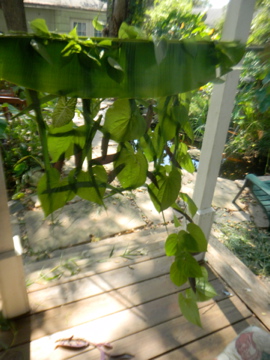
day, Pollen heavy, sneezed often,
poked hands with thorns, decide
Goldsworthy is fun, but not my cup of tea.
Then I thought, “banana leaves.” Not something I thought of on my own,
an idea that stemmed from a Goldsworthy book. I though I’ll hang them and weave things in between them! Oh, certainly this idea would be marvelous and though the artwork that I would labor for hours on would only be temporary, that was the point of this exploration. I was trying to move away from my traditional bronze work for a time to work things that were opposite—not permanent. So, I cut a banana leaves and then another and then another and in hindsight I probably should not have cut them until I absolutely needed them. I thought I heard Goldsworthy fussing at me. The first leave tore terribly, and I adjusted my idea. A banana leaf hanging from something, but what… Oh yes, one of the million of pieces of bamboo that I cut and were now piled knee high in my yard. I felt vindicated. I was on a roll. Later I added donax leaves, potato vines, and other elements to this hanging art. You know, I did enjoy creating this way, even though I was sneezing terribly. I liked looking at the textures and color of my garden and combining them in a way that I had not thought of. I held the banana leaf for a very long time, just feeling its weight, looking at the color, and oh yes, washing off the bird poo. I also thought it was marvelous that the bougainvillea plant on the side of my house that I have been impaled on more than once, now had a purpose. I had plenty of thorns to secure lots of natural pieces.
I have decided to appreciate Goldsworthy from afar. Especially after my experiences with nature. (I feel I have a part of me that is very sad for my inability to coexhist and create with my nature.) I know his descriptions of his artwork usually talk about the weather or the cold or how long it took, or that it fell down and he started over. I give him credit for his tenacity. You know, I do remember reading once that Goldsworthy peed on ice to get it to stick. I think that would be going a little too far, or maybe it would just be harder for a woman than a man, and besides, I would be hard pressed to find ice in Houston at any time of the year. I can only determine that he really enjoys creating in nature to endure and persevere.
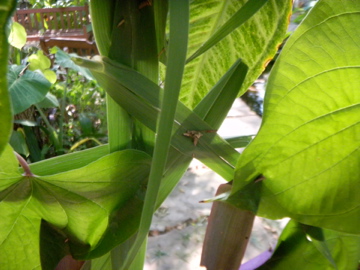
the bougainvillea thorns that I have injured myself on.
One of my biggest distractions of trying to Goldsworthy was my need to do other things in the yard. Clip this plant, move this piece of garden art or fix this part of the pond. I realize that my oasis that I have created out of my yard is my Goldsworthy. The weaving of textures, of height, and color, the exploration of sound by bringing in a waterfall and stream, even the live creatures that now live here. I and my canvas have even endured the natural hardships. I look at the 15 foot tall bird of paradise that hangs over- dead from the very long freeze we had last winter. But I’m delighted with the babies at her dying feet. My canvas will change a bit, but we will also preserver.
I have enjoyed my exploration, and am glad that my turtles are alive. I’m pleased to have washed the pollen out of my hair and the critters off my skin. Not that I mind either, it is just that if I am going to do that I would rather work on my yard and canvas. A lasting Mongeon creation that keeps on giving. I will leave my nature interaction for my garden, the one that I travel through each day and marvel at, as I am on my way to the studio to create!

Bridgette Mongeon is a sculptor, writer and educator as well as a public speaker. Her blog can be found at https://creativesculpture.com.
She is also the owner and creator of the God’s Word Collectible Sculpture series
Follow the artists on twitter twitter.com/Sculptorwriter twitter.com/creategodsword
Facebook http://www.facebook.com/bridgette.mongeon
Listen to The Creative Christian Podcast or the Inspiration/Generation Podcast Click on Podcast Host Bios for a listing of all podcasts
Listen to the Art and Technology Podcast
You Could Lose Your Rights To All The Work You Have Ever Created
Created for Best of Artists and Artisans web site
By Bridgette Mongeon © 2008

Immediate action is needed concerning the
Senate Bill S. 2913 and House Bill H.R. 5889, the Orphan Works Acts of 2008.
America is known for the country that protects an individual’s rights. It is impossible for me to comprehend that my rights as an artist may soon drastically change, and that I could lose the rights to all the work that I have ever created. When I first heard about this, it was so unbelievable that I thought that it must be a prank. But, with further investigation I found it was not. In this article I will include a little about what I found and links with other articles for readers to peruse so that they can make their own informed decision. I am also setting up interviews with several people including Copyright lawyers, those in the writers unions, and even those in the American Federation of Television and Radio artists, to name a few. There is urgency in acting and spreading this information. For whatever reason, this is moving through congress quite quickly and will affect your rights and possibly your income as a creative person.
As I find more information and create these interviews, I will pass them on to the Editors at Best of Artists and Artisans sculpture blog to be posted at their discretion. I will also post all of the information that I find on my home page blog, located at https://creativesculpture.com/blog
COPYRIGHT LAW AS IT STANDS TODAY
First, a few basics about copyright law as it stands today. According to the copyright law of 1976, everything that you create is protected by copyright from the moment you create it, even if it is not registered. This is the way copyright is handled throughout the world. It was defined by the Berne convention, which is an international agreement concerning copyrights.
With the current Copyright law, you do need to register your work if you want to collect for statutory damages for infringement. If, however, your work is registered and you discover someone has stolen it and you file suit, statutory damages are punitive and can be quite severe for those infringing on someone’s rights. This very idea keeps many people honest about “taking” other people’s artwork.
“It is not what it appears to be, it is a Trojan horse… Under this orphan works legislation, nothing you do would be protected unless it is registered with these commercial registries… they are orphaning all unregistered work” Brad Holland
THE CHANGE IN LAWA radically proposed change to the US copyright law allows infringers to exploit the right of copyright holders with little or no penalty according to the Orphan Works Opposition Headquarters (OWOH). “Two bills currently on the “rocket docket” would let infringers “orphan” any copyrighted work whose owner the infringer failed to locate through a vaguely defined “reasonably diligent” search. The creative arts industry, including world-renowned artists, designers, photographers, manufacturers, and licensing businesses have united to oppose this legislation.”
The New Orphans Work Act declares that nothing you do would be protected unless you register it with a registry, placing a burden of diligence on the copyright owner. It must also be stated that even though these bills are moving quite fast through congress, registries do not, at this time, exist. These would be private registries where an artist would be responsible to register their art. In other words, every artist will have to pay to own their own work and each of their pieces will have to be registered, right down to the sketches in their sketchbook. If they are not and someone comes across your work and they search these directories and do not find it, then they can say that they performed a “reasonably diligent search.” They can use your work at no cost. As I comprehend the ramifications of this, the works that are presently copyrighted would also have to be reregistered. The cost of registering each piece of artwork, nevertheless the time that it would take to register each piece of artwork throughout an artists lifetime, makes this task impossible and prohibitively expensive.
It is interesting to note the following—It is a violation of the Berne Convention for the Protection of Literary and Artistic Works for any country to impose registration on a rights holder as a condition of protecting his copyright. See Article 5(2) “The enjoyment and the exercise of these rights shall not be subject to any formality (emphasis added).”, (From How the Orphan Works Bills Affect Visual Artists. Illustrators Partnership of American)
According to some of the interviews that I have listened to a creative person would also have to police their artwork, making sure that no one has taken it or it may be considered orphaned.” It is also said that you would have to reply to all inquiries on your artwork or it might be considered orphaned. All of this hardly leaves room for an artist to create.
OWOH states, “The new bills would severely “limit” financial penalties for infringing. Opponents charge this will encourage deliberate theft because statutory damages are the only tool the law gives copyright holders to prevent abuse– and they say it works. Penalties for infringement almost certainly deter rampant abuse by making it risky. But as medical illustrator Cynthia Turner notes ‘the new bills would protect infringers by denying artists damages, incurred court costs, attorneys’ fees and other expenses.'”
“Because these bills were planned behind closed doors, introduced with little warning and fast-tracked for imminent passage, a broad-based coalition of artists and trade associations say they have had little time to respond and generate public discussion. They say that a radical change in intellectual property law should not be rushed through Congress without public vetting. They are calling on Congress to slow down this legislation until it can be subjected to an open, informed and transparent public debate.”
Those in support of this bill are libraries and educators that claim that this bill is intended to give libraries and museums greater latitude to commercialize archived works. But, according to tp the OWOH, “critics charge the bills have been drafted so broadly they would permit any infringer to commercially exploit any copyrighted work, from professional art to family photos.” Those supporting the bill say that if artwork is worth something it should be registered. But if it is not worth something why would others want to take it?
Brad Holland of the Illustrators Partnership of America comments on the bill, ‘It is not what it appears to be, it is a Trojan horse… Under this orphan works legislation, nothing you do would be protected unless it is registered with these commercial registries… they are orphaning all unregistered work”
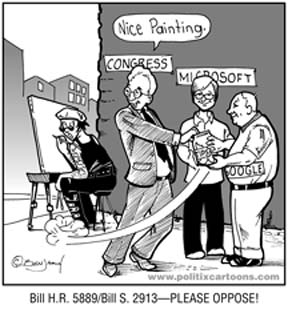
I encourage you to become familiar with the bill and take action accordingly. Your rights may be fading away without you even knowing it. If you would like to have your voice heard, The Illustrators Partnership of America has made it quite easy to take action. You can go to the web site and send an email, but faxes and letters are also encouraged. Please keep coming back for further information on this subject and send a link to this blog to other creative people that you know.
OTHER RESOURCES
Don’t take my word for it. You must decide how important this is to you. Here are some places to start.
- A wonderful resource of articles about this bill put out by the Illustrators’ Partnership
For comprehensive bill descriptions that describe the impact on visual artists:
House Bill http://capwiz.com/illustratorspartnership/issues/bills/?billid=11320236
Senate Bill http://capwiz.com/illustratorspartnership/issues/bills/?billid=11322171 - Video interview with brad Holland of the Illustrator’s Partnership
- American for the Arts on the Orphan words Legislation
- American Society of Media Photographs Update on 2008 Orphan Works Legislation
- Lawrence Lessig’s Op-Ed piece, in today’s New York Times
- Art Calendar article on the Orphan Works Act that also talks about Microsoft’s and Googles involvement.
- Public Knowledge concerning the Orphans work act
- Orphan Works Opposition Headquarters
- Plagiarism Today has several articles about the subject
- Attorney Tammy L Browning- Smith discusses the orphans works and Washington DC in her online blog Arts and crafts law
- Photography Director Rob Hagart discusses H.R.5889 ORPHAN WORKS ACT OF 2008 (INTRODUCED IN HOUSE) on his online blog
- An article from The Artist Foundation about the Orphan works Act
- The American Society of Media photographers throws in the towel and gets behind the bill, Johnathan Bailey describes why in this article ASMP Supports Orphan Works Bill. This site also has a video
- Mind Your Business: Don’t Lose the Rights to Your Artistic Creations, Animation World Magazine’s Mark Simon reports on alarming new developments in his continuing campaign against the Orphan Works Act.
- Why the Orphan Works Act is Uncles Sam’s Thieves’ Charter written by the Editorial photographers United Kingdom and Ireland
- A podcast with Alex Saviuk cartoonist of the spider man comics





